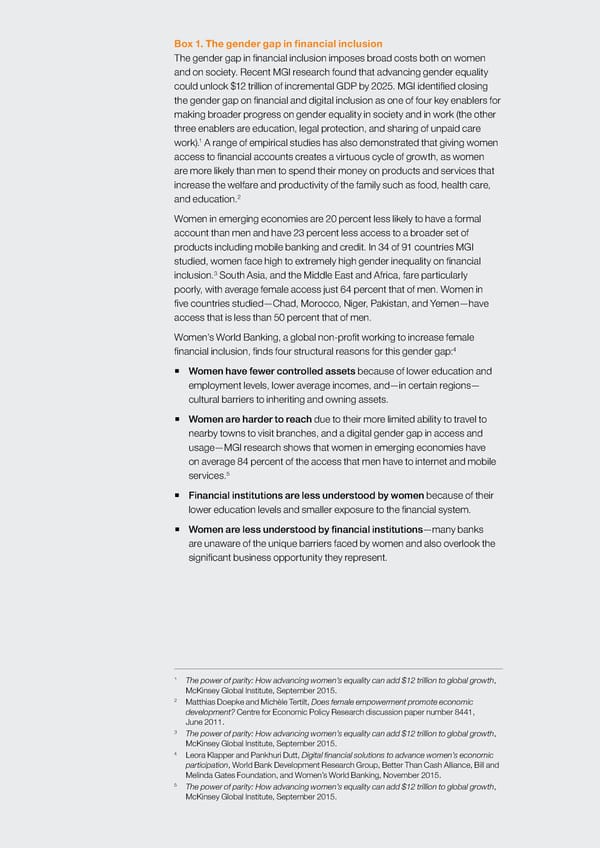Box 1. The gender gap in financial inclusion The gender gap in financial inclusion imposes broad costs both on women and on society. Recent MGI research found that advancing gender equality could unlock $12 trillion of incremental GDP by 2025. MGI identified closing the gender gap on financial and digital inclusion as one of four key enablers for making broader progress on gender equality in society and in work (the other three enablers are education, legal protection, and sharing of unpaid care 1 work). A range of empirical studies has also demonstrated that giving women access to financial accounts creates a virtuous cycle of growth, as women are more likely than men to spend their money on products and services that increase the welfare and productivity of the family such as food, health care, 2 and education. Women in emerging economies are 20 percent less likely to have a formal account than men and have 23 percent less access to a broader set of products including mobile banking and credit. In 34 of 91 countries MGI studied, women face high to extremely high gender inequality on financial 3 inclusion. South Asia, and the Middle East and Africa, fare particularly poorly, with average female access just 64 percent that of men. Women in five countries studied—Chad, Morocco, Niger, Pakistan, and Yemen—have access that is less than 50 percent that of men. Women’s World Banking, a global non-profit working to increase female 4 financial inclusion, finds four structural reasons for this gender gap: ƒ Women have fewer controlled assets because of lower education and employment levels, lower average incomes, and—in certain regions— cultural barriers to inheriting and owning assets. ƒ Women are harder to reach due to their more limited ability to travel to nearby towns to visit branches, and a digital gender gap in access and usage—MGI research shows that women in emerging economies have on average 84 percent of the access that men have to internet and mobile 5 services. ƒ Financial institutions are less understood by women because of their lower education levels and smaller exposure to the financial system. ƒ Women are less understood by financial institutions—many banks are unaware of the unique barriers faced by women and also overlook the significant business opportunity they represent. 1 The power of parity: How advancing women’s equality can add $12 trillion to global growth, McKinsey Global Institute, September 2015. 2 Matthias Doepke and Michèle Tertilt, Does female empowerment promote economic development? Centre for Economic Policy Research discussion paper number 8441, June 2011. 3 The power of parity: How advancing women’s equality can add $12 trillion to global growth, McKinsey Global Institute, September 2015. 4 Leora Klapper and Pankhuri Dutt, Digital financial solutions to advance women’s economic participation, World Bank Development Research Group, Better Than Cash Alliance, Bill and Melinda Gates Foundation, and Women’s World Banking, November 2015. 5 The power of parity: How advancing women’s equality can add $12 trillion to global growth, McKinsey Global Institute, September 2015. McKinsey Global Institute Digital finance for all: Powering inclusive growth in emerging economies 21
 DIGITAL FINANCE FOR ALL Page 32 Page 34
DIGITAL FINANCE FOR ALL Page 32 Page 34